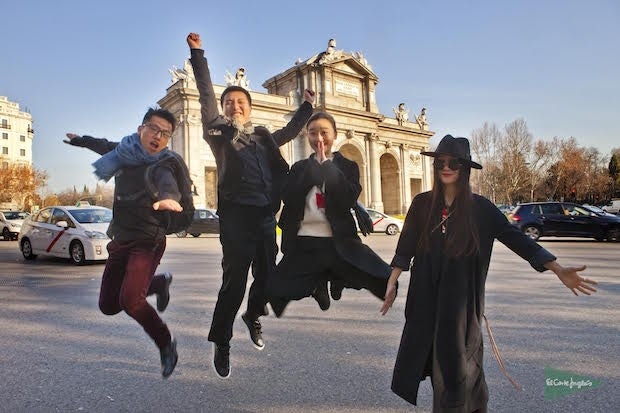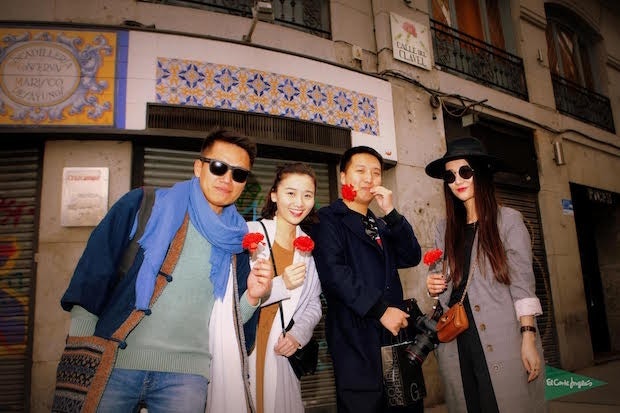
Although France and the UK get most of the headlines, in recent years Spain has quietly become one of the most popular destinations for Europe-bound Chinese travelers. Already the country’s biggest-spending tourist segment—sitting at an estimated $1,085 per person per trip—Chinese tourists are also becoming a more powerful force at major department stores and luxury boutiques.
In 2014, Spain attracted a record 287,866 Chinese tourists, while around 300,000 visited last year—a drop in the bucket compared to the United States or South Korea, but nothing to brush off, owing to their outsized spending power.
Naturally, Spain’s El Corte Inglés—the largest department store chain in Europe—has seen an increase in Chinese shoppers over the past several years. For many Spain-bound Chinese tourist-shoppers, a trip to Madrid isn’t complete without stocking up at ECI.
Yet standing out online, particularly on Chinese social platforms like Weibo and WeChat, can be a challenge—particularly for retailers with no offline presence in mainland China.
To strengthen its position as a "must-visit" for Chinese travelers, ECI sought to give potential Chinese visitors an insider’s view of Madrid to firmly place itself in the context of Spain’s arts, fashion, culinary, and cultural spheres.
Rather than doing this via a major advertising push in China or a celebrity spokesperson—which, as we’ve shown, is showing diminishing returns for Western brands—ECI hosted a group of four rising Chinese digital influencers in Madrid, showcasing the city (and Spain) as inspiring destinations for experience-hungry travelers.
Beyond the usual wining-and-dining, which companies regularly do for coverage, ECI’s campaign sought not only to impress the attendees but also expose their specific fan bases to the sides of Spain that they would find interesting. Working with China Luxury Advisors and influence intelligence firm Enflux, ECI was able to reach the right audience of Chinese consumers—those who are most likely to travel to Spain.

The tour immersed the influencers—whose specialties spanned travel, lifestyle, culture, and fashion—in a four-day tour of the Spanish capital. The itinerary focused on "historical secrets" (a walking tour of the Madrid de los Austrias and Las Letras, photo shoots in the Salamanca district and at the Royal Palace, and a private visit to the atelier of luthier Felipe Conde) as well as glimpses of "modern Madrid" (a cocktail master class with Diego Cabrera, a private visit to the Reina Sofia Museum, fashion-walking tours of Tribal District, and a Real Madrid game).
The attendees stayed in two of the best hotels in Madrid, the Villamagna hotel and the Ritz by Mandarin Oriental, and enjoyed some of the country's best culinary destinations. (Which included 175 year-old L’Hardys, two-Michelin-star chef Paco Roncero's restaurant Domo in NH Eurobuilding, Gourmet Experience Callao by El Corte Inglés, and Ramon Freixa’s two-Michelin-starred restaurant at the Unico Hotel.)
As one of the influencers, Jinpeng Zhang, author of five popular books on independent travel, commented, "This is my third trip to Madrid, and this experience curated by El Corte Inglés allowed me to see a whole new side of [the city] that I never even knew existed.”
Zhang added that he was impressed “with the food, culture, and history that Madrid has to offer Chinese visitors.”
In addition to cultural immersion, El Corte Inglés showcased Spanish fashion, hosting a styling, make-up, and photo session at the Royal Palace of Madrid, and an introduction to Spanish style trends hosted by ECI's Director of Fashion. El Corte Inglés officially inaugurated the start of Chinese New Year with a reception at its Castellana flagship store, with attendees that included the Chinese Ambassador to Spain.

Fashion and travel columnist and photographer Mok, one of the four influencer attendees, said, "Spanish people are known for their love for life, which is evident through their passion for arts, culture and food. Such passion is so contagious that you feel it at every street corner in Madrid, and in every conversation you have with a local."
According to Lisa Dinh, the Head of Asian Markets in International Tourism at ECI, the increasingly central importance of digital media to Chinese consumers means creative campaigns are crucial, particularly around major holidays.
Dinh, who called the tour “fun and effective,” added that one aspect that made the trip so effective was that “the four amazing Chinese influencers saw Madrid just as the Madrillians do.”
As any smart marketer knows, simply flying people from China to your store or studio is only half the battle. Getting their audience excited and engaged is where the real ROI happens.
To this end, ECI worked with the influencers to launch a photo-voting contest, “Madrid Moments,” encouraging their Weibo and WeChat fans to vote on their favorite photos from the trip. Further promoted by a group of seven micro-targeted, influential China-based individuals, the photo-voting campaign racked up well over 1.2 million hits on Weibo, and more than 2,000 votes on WeChat.
With any large-scale campaign, the question is always, “What was the ROI?” With the aim of increasing its Weibo and WeChat following, ECI’s campaign was a rousing success. From February 1-29, ECI’s Weibo following increased more than 90 percent, while its WeChat fan base jumped nearly 500 percent.
Perhaps more importantly, inbound inquiries to the retailer’s official WeChat account skyrocketed, giving ECI valuable insight into the interests and concerns of potential shoppers and jump-starting digital CRM efforts.
Additionally, ECI has already registered an uptick in interest for certain items in the wake of the successful campaign. Said Lisa Dinh, “We were thrilled to notice greater interest among Chinese clients in ‘Made in Spain’ products, [particularly] leather accessories and shoes among both men and women.”
Dinh also noted more interest in gourmet items like Jamón Ibérico, Spanish red wine, and Cava, as well as soccer-themed items.
Dinh noted that Chinese shoppers continue to show an appetite for luxury, noting that, "luxury accessories and watches and jewelry have always been popular amongst the Chinese clientele.” One important development pointed out by Dinh is that ECI is “noticing an increasing demand for local fashion and designers.”
A major takeaway from ECI’s Chinese New Year campaign is that it doesn’t matter if you have stores inside China or not. It’s still possible to get the China market interested and excited in your brand, given you take a creative approach, and build an authentic connection with the consumer by giving them real insight into who you are.
In addition to its influencer tour, El Corte Inglés also engaged Chinese New Year visitors offline, with special in-store luxury brand promotions and offers, as well as floral decorations and a three-meter wishing tree (where nearly 700 customers shared their wishes for the year of the monkey).
In addition to its aforementioned Weibo and WeChat efforts, the retailer also launched a "digital wishing tree" to engage WeChat fans.
By all measurements, ECI’s month-long, multi-faceted Chinese New Year campaign succeeded by taking a more tailored, nuanced, and long-term approach to China, seeing the market as a long-term goal rather than a giant wallet.
To China’s more jaded, hard-to-please shoppers—for whom celebrity campaigns (and most blogger collaborations) come across as inauthentic money-grabs—a campaign that combines culture, access, and the right tone will always come across as more authentic (and fuel better ROI) than "one-shot" attempts to drive buzz.
